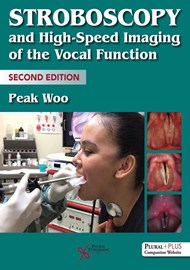When I was asked to review this book, I was really looking forward to receiving it and eagerly awaited the postman on a daily basis until it arrived. Needless to say, it did not disappoint. The author, Peak Woo, is well known in laryngology circles and this is the second edition of this very informative book.
This 437-page book is organised into two roughly equal parts. The first part consists of 12 chapters and is a detailed account of basic sciences, anatomy, mechanics and introduction to stroboscopy. The latter part is specifically on laryngeal disorders. There are associated web pages that house the 4k videos accompanying the text – these really help to add context.
This book will appeal to ENT surgeons with an interest in laryngology, as well as speech and language therapists. It has incredibly clear descriptors and possibly the best explanation of stroboscopy that I have ever read. It even goes so far as giving a historical narrative to stroboscopy from its 19th century evolution, from slits in wheels and laryngeal mirrors to modern-day high-quality digital image capture.
The anatomy and physiology within the first part is detailed enough for the majority of ENT surgeons and those in training for their final exam. The images and diagrams are of very high quality and will further aid one’s understanding. I particularly enjoyed the chapter on videokymography, mainly because it is something new and not used in my everyday practice; although after reading this chapter, I wish it was. Part one concludes with some good practical information on how to set up stroboscopy, as well as interpreting the images.
Part two is more focused on laryngeal disorders and, whilst this text is not an atlas of laryngology, there are some very high-quality images. It focuses on more common laryngeal pathology that anyone with an interest in laryngology will encounter on a frequent basis. There are lots of high-quality montages explaining the effect of this pathology on the cords. Where surgery is the management of choice for these conditions, there is a small operative note explaining the steps involved.
The section on vocal fold paralysis versus paresis is particularly useful and often debated at meetings; here, it is summed up in a few pages.
Overall, it is clear why Peak Woo is regarded as an expert laryngologist, and this book highlights Peaks’ passion to pass on the information for one generation to the next. I would give this book 5/5 and would encourage anybody undertaking and laryngeal work/voice clinic to read it just to further aid their own understanding.




